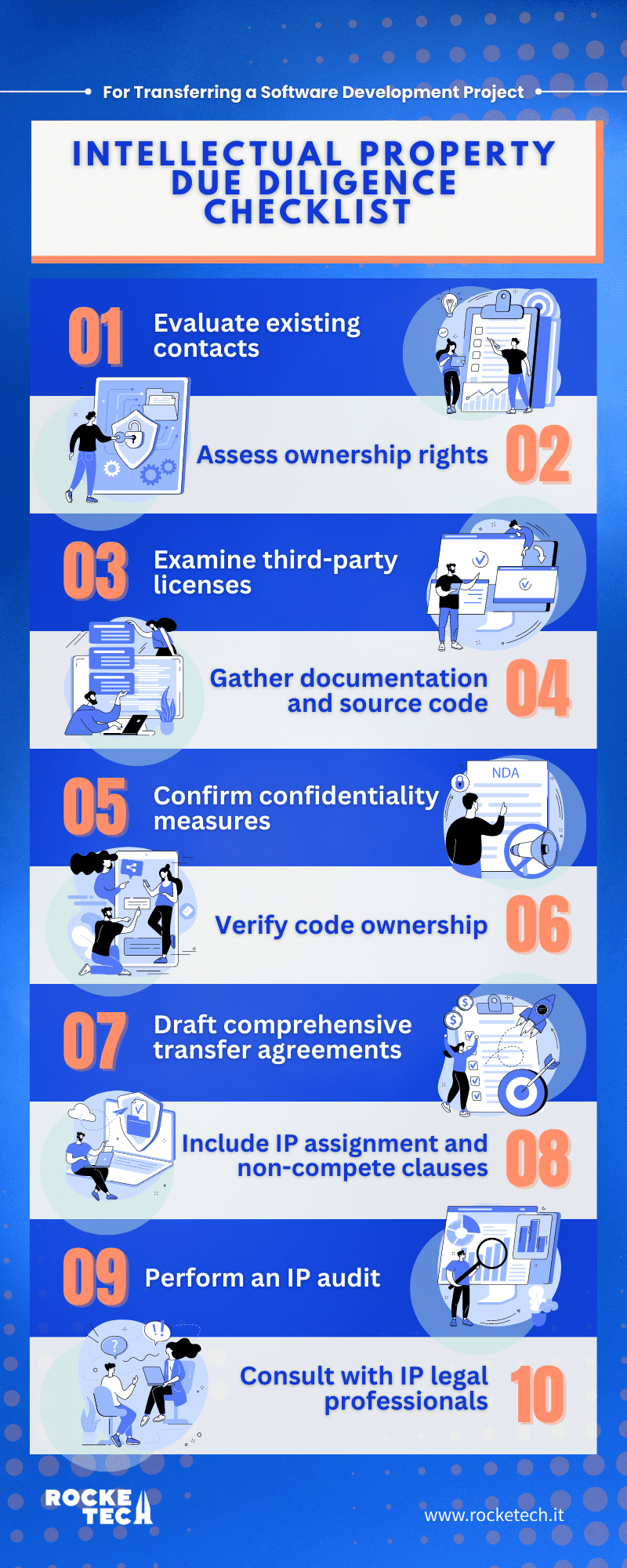Imagine you’ve invested a lot of effort and resources into your brainchild. Inevitably, you reach the moment when your project grows and evolves. It’s the time to expand, level up, or change the development team.
But amid this crucial phase, you find out that the access to GitHub repositories belongs to that one developer you had to fire a month ago. On top of that, parts of the project documentation are missing. Does this sound familiar? It’s a frequent challenge of intellectual property transfer faced when changing the development team.
What do business owners need to know about assigning IP rights? How can startups protect themselves before the potential IP handover during the team migration? What are effective ways to handle intellectual property in a startup? We answered these questions in our guide.

What Happens When Businesses Ignore IP Protection Guidelines
While replacing development teams usually means evolution and advancement, it also poses critical risks to a business. When startups are initially launched, founders often overlook the significant potential pitfalls that may arise as the new company progresses and transitions into a fully-fledged business.
Lost Access to Source Code
Imagine your startup decides to switch development teams, but (for whatever reason) the former team refuses to grant access to the source code. Maintaining and improving the existing project becomes a daunting challenge. Bugs become harder to fix, new features are nearly impossible to implement, and progress comes to a grinding halt, leaving your venture in a race against time to regain control.
Who Owns the Source Code?
Ownership disputes over the source code happen all the time. The previous development team may claim ownership. In the worst-case scenario, they will get the power to restrict your startup’s ability to make changes or monetize the software. Legal conflicts drain resources, stall development, and bring uncertainty and vulnerability.
Restricted Access to GitHub and Bitbucket Accounts
Your startup is ready to move further, but the previous development team owns the GitHub or Bitbucket account used for version control. Metaphorically speaking, they can hold your project hostage — they can alter, delete, or deny access to the repository.
Missing Specialized Knowledge
Imagine transitioning to a new development team, only to find that critical specialized knowledge held by the previous team is no longer accessible.
Their insights into the software architecture, unique problem-solving approaches, and domain-specific expertise vanished. Restoring the knowledge essentially means starting all over again.
The Catastrophe of Intellectual Property Transfers
In a nutshell, mishandling IP most likely will result in a disaster that can cost you your business. Not documenting or executing ownership or licensing rights properly always leaves startups vulnerable to legal disputes. Competitors claiming infringement, breaches of contract, or misappropriation are just one example of IP implications especially when switching development teams.
Laying the Groundwork: The List of Transferable Intellectual Property Assets
First things first: to protect your IP assets, you need to understand what they are. Often, startups forget that intellectual property extends beyond patents and includes elements like logos, names, designs, interfaces, and code. It is crucial to acknowledge and safeguard these assets accordingly.
Logo
A logo is a copyrighted object containing images, graphics, or proper names. There’s often confusion between a logo and a trademark. Businesses can protect a logo similar to the way a trademark is protected. It means the creator can prohibit using their design and fonts (if they were developed for the logo). However, only the trademark holder can prohibit using specific words and phrases.
Design
Design elements are protected by copyright and safeguard the visual representation. Similarly to the case of logos and trademarks, the copyright does not prohibit placing the elements but forbids placing them in a particular way.
Business Logic
Business process flowcharts are essentially know-how under a trade secret. Its power is that it can serve as a basis for software patents. However, initially, you should protect it by copyright, describing it as a script.
Business Model
A business model (instructions, regulations, checklists, scripts, and offers) is also an object of copyright. It’s the ‘fabric’ you build your operational management with. It’s also the subject of a license agreement for scaling the business and the basis for payment of royalties to the founder.
Device Blueprints
Device blueprints, along with the external appearance of a product, are protected from copying and reproduction. Copyright and patent laws apply to safeguard schematics in a way similar to interface protection.
Computer Programs
Computer programs are protected by copyright. They cannot be patented unless they involve business logic, which solves functional tasks and is not a conventional method of conducting business activities.
Data
Data is know-how under a trade secret. In fact, it can be any data that may be of commercial value. Non-disclosure agreements (NDAs) are signed to protect data. It doesn’t make much sense to sign an NDA regarding something else, as know-how does not safeguard other objects — only information.
Establishing Company Accounts for Intellectual Property Management
Setting up company accounts related to your startup’s intellectual property will help you avoid many mistakes and mitigate many risks at later stages. Besides, a developed account and documentation system will also help you streamline operations and ensure a smooth transition when transferring projects to different software development teams.

#1 GitHub and Bitbucket
Choose a reliable version control platform like GitHub or Bitbucket to store and manage your source code. Create a company account and establish a clear repository structure that separates different projects and ensures version control.
#2 App Stores
If you plan to release software applications, create accounts on relevant app stores, such as Apple App Store, Google Play Store, or Microsoft Store. Familiarize yourself with their submission guidelines and review processes to comply with their IP and copyright requirements.
#3 Documentation and Knowledge Base
Utilize tools like Confluence, Notion, or Google Docs to create a centralized documentation and knowledge base. Categorize information related to your projects, codebase, API documentation, user manuals, and copyright notices to ensure easy accessibility and reference.
#4 Task and Project Tracking Software
Implement a project management tool like Jira, Trello, or Asana to track tasks, assign responsibilities, and monitor project progress. Use clear labels and categories to distinguish projects and associated IP-related tasks effectively.
#5 Trademark Registration
Research and register your company name, logos, and relevant trademarks with the appropriate intellectual property offices in your jurisdiction. Seek legal advice to navigate the registration process correctly and protect your brand identity.
#6 Domain Registration
Secure your online presence by registering domain names relevant to your company, products, or brands. Choose a reliable domain registrar and renew your registrations on time to prevent unauthorized use.
#7 Open-Source Software Usage
If utilizing open-source software components, maintain a comprehensive inventory and track licenses using tools like Mend.io, FOSSA, or FOSSology. Regularly update and review your open-source dependencies to ensure compliance with licensing obligations.
#8 Trade Secret Protection
Implement measures to protect trade secrets, such as restricted access controls, non-disclosure agreements (NDAs), and internal policies that outline how confidential information should be handled. Safeguarding trade secrets is crucial to prevent their unauthorized disclosure.
#9 Legal Consultation
While it’s possible to set up your startup’s IP management system, it may be overwhelming to do so single-handedly. Seek guidance from intellectual property attorneys to ensure compliance with IP laws and regulations. They can advise on creating appropriate agreements, reviewing legal documents, managing IP-related risks throughout the entrepreneurial journey, and protecting your IP when changing teams.
IP Due Diligence Checklist for Transferring a Software Development Project
Most problems occur because startups don’t establish the proper workflows for managing and protecting at the beginning stage or are unaware of providers who develop compliance solutions. If everything is done right, the process of intellectual property handover shouldn’t be a problem. We prepared a checklist of the essential steps to take when it’s time to change your development team.

- Evaluate existing contacts ✔
Review contracts with the current development team to identify provisions related to IP ownership, confidentiality, and non-disclosure agreements. Understand any restrictions or obligations that may impact the transfer process.
- Assess ownership rights ✔
Determine the ownership of IP assets developed during the project. Ensure there are explicit agreements stating that the startup retains full ownership, regardless of the development team involved.
- Examine third-party licenses ✔
Evaluate licenses for third-party software components and open-source libraries used in the project. Ensure compliance with license terms and understand any obligations or restrictions when transferring the project.
- Gather documentation and source code ✔
Collect all relevant documentation, including design specifications, source code repositories, and version control records. Verify that documentation is well-organized and up-to-date to facilitate a seamless handover to the new development team.
- Confirm confidentiality measures ✔
Assess the existing development team’s implementation of confidentiality measures to protect the startup’s sensitive information and trade secrets. Check for access controls, non-disclosure agreements, and data security protocols.
- Verify code ownership ✔
Determine if the development team utilized any pre-existing code or frameworks. Ensure appropriate licenses and permissions are in place or validate that the code is original and owned by your legal entity.
- Draft comprehensive transfer agreements ✔
Create a transfer agreement that explicitly states the transfer of IP ownership, confidentiality obligations, and any necessary warranties or indemnifications to safeguard the startup’s interests.
- Include IP assignment and non-compete clauses ✔
Incorporate IP assignment clauses in the new development team’s agreements to ensure all intellectual property created during the project is transferred to the startup. Consider non-compete clauses to prevent competition in the same market.
- Perform an IP audit ✔
Conduct an IP audit to identify potential risks, infringements, or gaps in IP protection. Address any issues discovered during the audit and take necessary actions to mitigate risks.
- Consult with IP legal professionals ✔
Engage experienced intellectual property attorneys to review contracts, provide guidance on IP transfer, and ensure compliance with relevant laws and regulations specific to your jurisdiction.
Navigating Intellectual Property in Startup Environments
Imagine a startup called TechSolutions. It has developed a groundbreaking software solution for efficient data analysis and is now seeking funding from VentureCapital Partners (VCP). However, VCP discovers during due diligence that TechSolutions lacks proper IP management and protection. The startup failed to file patents or register trademarks and lacks internal policies for safeguarding trade secrets. On top of that, VCP finds that TechSolutions has a loosely defined ownership structure, with an unclear assignment of IP rights from its founding members. This lack of clarity equals significant legal risks and potential disputes over IP ownership.
As a result, despite TechSolutions’ promising technology and market potential, VCP decides not to fund the startup, citing doubts about its ability to secure and capitalize on its intellectual property assets.
A well-established and streamlined intellectual property system is a prerequisite for startups.
Investors prioritize projects with well-managed IP. By demonstrating diligent IP management, founders signal to investors that they have a strategic approach to protecting their innovations, fostering trust, and increasing the likelihood of securing funding to fuel their growth and development.
through the IP management processes?
Let’s discuss your concerns.